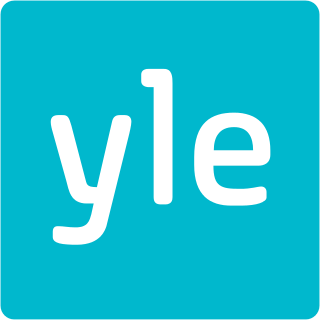The prime time or the peak time is the block of broadcast programming taking place during the middle of the evening for a television show. It is mostly targeted towards adults. It is used by the major television networks to broadcast their season's nightly programming. The term prime time is often defined in terms of a fixed time period—for example, from 8:00 p.m. to 11:00 p.m. or 7:00 p.m. to 10:00 p.m.. In India and some Middle Eastern countries, prime time consists of the programmes that are aired on TV between 8:00 p.m. and 11:00 p.m. local time.

Independent Television News (ITN) is a UK-based television production company. It is made up of two divisions: Broadcast News and ITN Productions. ITN is based in London, with bureaux and offices in Beijing, Brussels, Jerusalem, Johannesburg, New York, Paris, Sydney and Washington, D.C.

Yleisradio Oy, translated to English as the Finnish Broadcasting Company, is Finland's national public broadcasting company, founded in 1926. It is a joint-stock company which is 99.98% owned by the Finnish state, and employs around 3,200 people in Finland. Yle shares many of its organizational characteristics with its UK counterpart, the BBC, on which it was largely modelled.

Sveriges Television AB, shortened to SVT, is the Swedish national public state-controlled television broadcaster, funded by a public service tax on personal income set by the Riksdag. Prior to 2019, SVT was funded by a television licence fee payable by all owners of television sets. The Swedish public broadcasting system is largely modelled after the system used in the United Kingdom, and Sveriges Television shares many traits with its British counterpart, the BBC.

SVT1 is the primary television station of the Swedish public service broadcaster Sveriges Television in Sweden.

SVT2, is one of the two main television channels broadcast by Sveriges Television in Sweden.
In journalism, local news refers to coverage of events, by the news, in a local context that would not be an interest of another locality, or otherwise be of national or international scope. Local news, in contrast to national or international news, caters to the news of their regional and local communities; they focus on more localized issues and events. Some key features of local newsrooms includes regional politics, weather, business, and human interest stories. Local news readership has been declining in recent years, according to a recent study. And as more and more television consumers tap into streamed programming, local news viewership is beginning to decline. Nikki Usher, an associate professor at the College of Media at the University of Illinois, argued in The Complicated Future of Local News that "critical and comprehensive local news is a recent invention, not a core element of the history of American democracy.”
Yle Nyheter TV-nytt is the name of the daily television news programmes on the Swedish-speaking Finnish TV channel Yle Teema & Fem, at the Finnish Broadcasting Company (Yle). The programme is also broadcast on TV Finland.

Aktuellt is a Swedish nightly news programme produced by Sveriges Television (SVT) and broadcast on its second channel, SVT2 in Sweden.

SBS World News is the news service of the Special Broadcasting Service in Australia. Its flagship nightly bulletin is broadcast at 6.30pm on SBS with additional weeknight 'late' bulletins from 10.30pm on SBS.

SVT24, stylized as svt24, formerly known as SVT 24 or 24 is a Swedish language TV channel broadcast by Sveriges Television (SVT). It started broadcasting in 1999 as a dedicated news channel. In 2003 it extended its scope to include other current events-related programmes and sports at the weekend. Nowadays the channel mainly consists of news, sports and entertainment programmes with a focus on reruns from SVT1 and SVT2.
SVT Barn, formerly Barnkanalen, is a Swedish free-to-air television channel from state broadcaster Sveriges Television dedicated to children's television programming.

TVNZ 1 is the first national television channel owned and operated by the state-owned broadcaster Television New Zealand (TVNZ). It was one of the major television broadcasters in New Zealand, starting out from 1960 onwards as independent government-operated facilities in the four main centres of Auckland, Wellington, Christchurch and Dunedin, and eventually began sharing programming between them all in real time in 1969, becoming NZBC TV. The collective group was renamed Television One in 1975 upon the break-up of the New Zealand Broadcasting Corporation, and became a part of TVNZ in 1980 when Television One and South Pacific Television merged. The channel assumed its current name in October 2016.

ABC News, or ABC News and Current Affairs, is a public news service produced by the Australian Broadcasting Corporation. Broadcasting within Australia and the rest of the world, the service covers both local and world affairs.

TV4 is a Swedish free-to-air television network owned by TV4 AB, a subsidiary of the Bonnier Broadcasting Group. It started broadcasting by satellite in 1990 and, since 1992, on terrestrial television. In 1994, TV4 became the largest channel and remained so for a number of years. The two channels of Sveriges Television (SVT) lost more and more viewers for a couple of years. After making schedule changes in 2001, SVT1 had practically the same numbers of viewers as TV4. From 2004 to 2019, the TV4 Group was a fully active member of the European Broadcasting Union.
A regional variation generally refers to times when a radio station or television station simultaneously broadcasts different programmes, continuity or advertisements to different parts of its coverage area. This may be so as to provide programming specific to a particular region, such as local news or may be so as to allow advertisements to be targeted to a particular area.

Rapport ("Report") is one of the two main news programmes from the Swedish television broadcaster Sveriges Television (SVT).
Television began in Sweden in 1954 with test transmissions, prior to the opening of the first station, Radiotjänst, two years later. A second channel was launched in 1969. Commercial television arrived in the 1980s through cable television and in 1992, the country's first terrestrial commercial channel was launched.
In broadcasting, continuity or presentation is announcements, messages and graphics played by the broadcaster between specific programmes. It typically includes programme schedules, announcement of the programme immediately following and trailers or descriptions of forthcoming programmes. Continuity can be spoken by an announcer or displayed in text over graphics. On television continuity generally coincides with a display of the broadcaster's logo or ident. Advertisements are generally not considered part of continuity because they are advertising another company.
Jonas Magnus Faxén was a Swedish journalist, diplomat and TV executive. He was Sveriges Television's (SVT) first CEO from 1978 to 1981 and served as Swedish consul general to New York City from 1988 to 1992. Faxén was Swedish ambassador in Tunis and a number of West African countries during the 1990s.